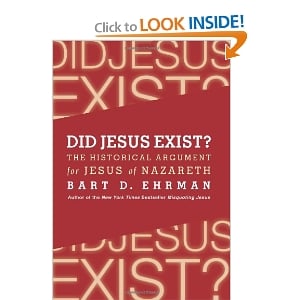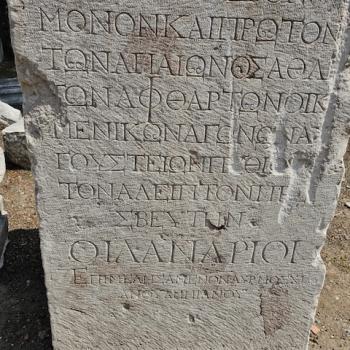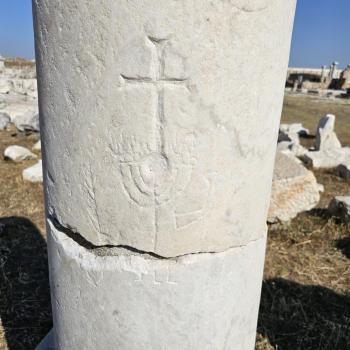Q. You spend most of the first third of the book laying out the evidence that in fact Jesus did exist, both Biblical and extra-Biblical, both Christian and non-Christian evidence. In your judgment, is there any of this evidence that you find much more compelling than other evidence, or is it simply that we have a wide variety of independent testimonies, and so the cumulative evidence is what is decisive for you?
A. It is obviously important for a historian to look at all the evidence. To most modern people, it is surprising to learn just how little evidence there is for Jesus outside the Christian sources. He is not mentioned in any Roman (or Greek, or Syriac, or… whatever – any pagan [i.e., non-Jewish, non-Christian]) source of the entire first century. Never. That strikes people as surprising. He is mentioned a couple of times within about 80 years of his life by two Roman sources (Pliny and Tacitus; I’m not sure Suetonius can be used). And he is almost certainly referred to twice in the Jewish historian Josephus, once in an entire paragraph. But that’s it for the non-Christian sources for the first hundred years after his death. It’s not much. But it’s something, and since these are not sources that based their views on the Gospels (since these authors hadn’t read the Gospels), it shows that Jesus was indeed known to exist in pagan and Jewish circles within a century of his life.
The really compelling evidence, though, comes in the Christian sources. Mythicists write these sources off because they are Christian and therefore biased, but that is not a historically solid way to proceed. Christian sources do indeed have to be treated gingerly, but they are sources every bit as much as pagan and Jewish sources are. What I show in Did Jesus Exist? is that there are so many Christian sources that can be used by historians that there is really no doubt at all that Jesus at least existed. Just to give an example (so as not to repeat my entire book here): by any credible dating, the apostle Paul must have converted to believe in Jesus within two or three years of the traditional date of Jesus’ death. And Paul knew some facts about Jesus’ life; he knew some of his teachings; he knew his closest disciple Peter; and he knew his brother James. Personally! If Jesus didn’t exist, you would think that his brother would know about it. The historian can not simply ignore what Paul has to say since he was a Christian. Taking his biases into account, we can use his letters for information about Jesus. And among other things, they show beyond a doubt that Jesus existed as a Jewish teacher in Palestine in the 20s CE. Otherwise we cannot explain Paul or his letters. That’s just one important piece of evidence for the existence of Jesus. I’ll discuss more in some of my later answers.
Q. Sometimes you make a distinction between literary evidence and other sorts of written evidence (e.g. records of trials or tax records), and you place especial stress on the former as a way of answering the question of whether or not Jesus existed. Can you explain why you do this?
A. Yes, there is a clear distinction to be made between literary and documentary evidence. The only reason I place special evidence on the former, when talking about the historical Jesus, is that there is no documentary evidence for his existence. (For lots and lots of historical issues, documentary evidence is invaluable; but only when it exists for the issue under consideration. If any did exist for Jesus, that would, of course, be highly significant.) We do not have any birth records or land deeds, no reports of his trial (other than in literary sources), and no death warrant related to Jesus – no documents (or inscriptions) of any kind. All we have are later literary references. And so these are the sources that we have to focus on.
Q. Of what value is the testimony of hostile witnesses to the existence of Jesus, for example the evidence from 3rd-4th century Jewish sources, or the evidence of Celsus’ views of things as cited by Origen? Must we necessarily rule out later evidence (from after the first or second century) if it comes from sources unlikely to have read any NT documents?
A. I don’t think this evidence is very valuable. By the third and fourth century there were indeed debates over Jesus significance – even earlier, as in the writings of Celsus from the 170s. But these hostile pagan (and in some cases Jewish – though the actual Jewish documents are later than the fourth century, even if their traditions can be traced to earlier times). But no one at that point, two or three centuries after Jesus’ death, had any independent access to his existence and life. Pagan authors such as Celsus and Porphyry, as well as their Christian opponents such as Justin, Origen, and Tertullian (the “apologists”) were basing their “knowledge” of Jesus on the Gospels and on oral reports about Jesus that were, for the most part, themselves derived from Gospels.
So the answer is that we do not necessarily have to rule out later evidence. We have to look at it as evidence to see whether it is valuable, important, and even independent. When we examine it closely, alas, it is not (not independent and therefore not valuable). If Celsus, for example, or Tertullian (on the other side) could be shown to have had access to earlier records that no longer survive for us, but which one time did exist and that provided independent testimony to Jesus, that would indeed be important! But, I’m sorry to say, they appear not to have had any such records.













